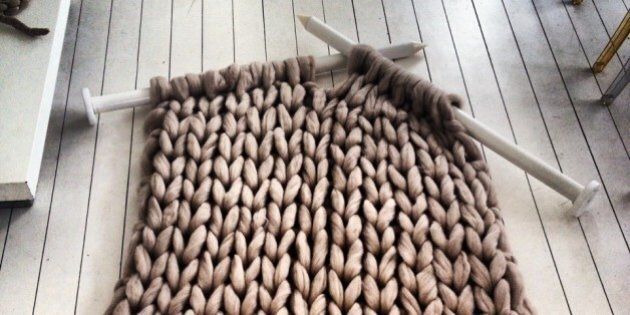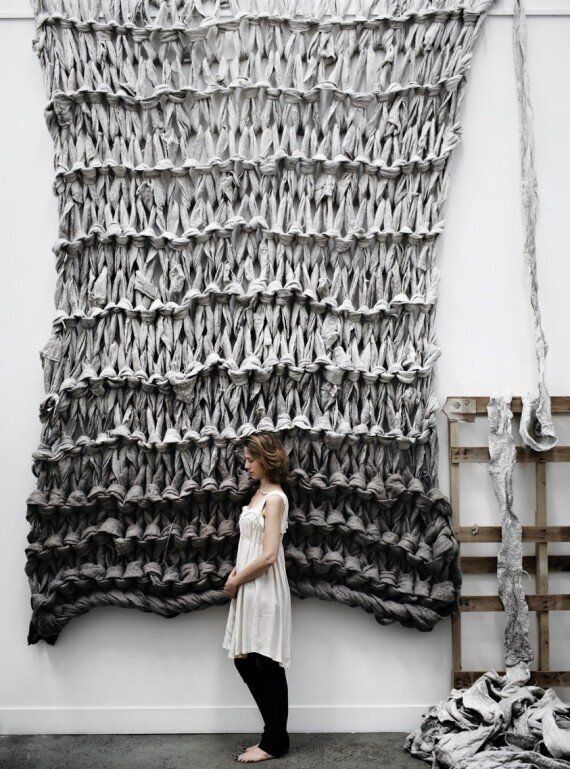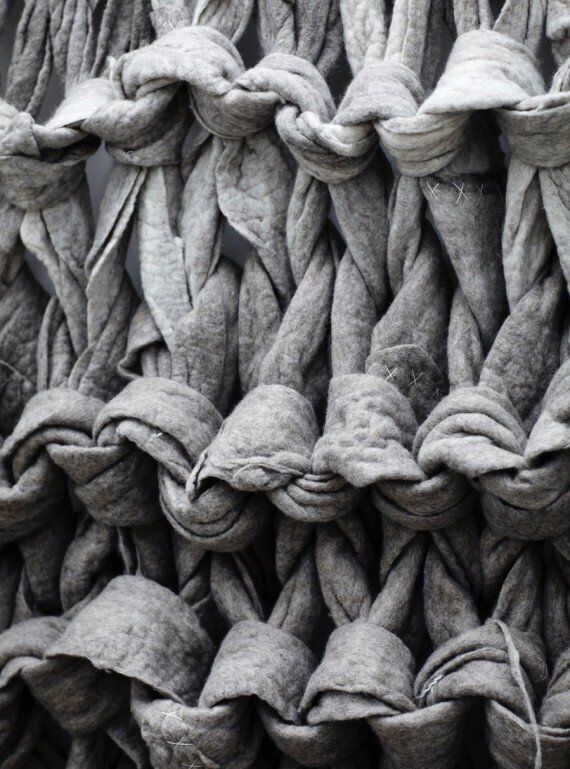

Knitting has never been cooler, as Jacqueline Fink demonstrates with her incredibly impressive large scale knitting installations. She spoke to The Huffington Post Australia about how any why she creates her masterpieces.
When did you start knitting?
"My Mum taught me how to knit as a child, but I never committed to learning the language of knitting so my skills remained very basic. When I think about it, I don’t think I ever finished a single project. It was always the journey that I found rewarding, not the outcome. Fast forward to the early years of my adulthood with a law degree under my belt, I found myself completely disillusioned with my chosen career. Life as a lawyer just did not suit. I left the law to work in my husband’s high end fashion retail business. I learnt many important lessons walking the retail floor, many of them brutal, but importantly it was during this time that my passion for high-grade merino wool was reignited. Three children then came along in fairly quick session and it was my choice to stay at home to care for them on a full time basis. I was totally unprepared for how difficult mothering can be and I felt like a failure. Post natal depression took a hold of me and many residual anxieties from my experience with my first born child became embedded into my everyday life without me even realising it.
By this time I was 35 and realised I needed to dig myself out of the hole I had inadvertently dug for myself. At that age, I knew myself well enough to know that I need to work creatively with my hands in some way. And so I began my search for a creative outlet in earnest. That same year, my Mum was diagnosed with a terminal lung disease. Scarily, the disease runs in the family and so we knew what Mum’s journey would look like. In my family’s case, it is very slow progressing until the end comes, which is then rapid. In the three years that followed Mum’s diagnosis we had some very big life affirming conversations. In one of them my Mum said to me that her only regret was that she had never fulfilled her true potential. Those words were like a knife to my heart and I reacted viscerally to them. On the spot, I vowed never to have the need to say that to my children on my death bed.
It was time to turn my ship around. I was done with not taking responsibility for my enjoyment and experience of life. The end came for my Mum on Halloween 2009. I could hear the onset of her decline over the phone on the Friday. By Sunday, I was on a plane travelling north to say my final goodbyes. As you can imagine, it was a deeply traumatic time for my family but in the very early hours of Monday morning my Mum received a double lung transplant with only minutes to spare. And so she lives and six years on she’s still going great.
In the days following my mum’s transplant, I found myself occupying a very heightened and surreal state. Quite frankly, I was on another plane completely. I don’t know how else to describe it. It was during this time that I had a vision which transformed my life and opened the door to a new life. While I was asleep, a big loud booming voice said to me, “You have to knit and it needs to be big”. The command was as terrifying as it was profound and it woke me from my sleep. But I had asked for guidance from the universe for so long that I didn’t dare question my vision. There was no way I wasn’t going to listen to it."
How did you turn knitting into a vocation?
"The day following my vision, without any external references, I set about discovering what knitting big meant to me, trusting my intuition implicitly. I took the instruction to knit big literally and so I knew regular yarn was not going to cut it and so I searched “off the grid” for months before I happened upon my first bag of merino wool roving -- straight from a farmer’s gate in South Australia. It was an instant love affair and I knew that I had found my joy. I had my Dad make up a set of industrial sized needles and I set about teaching myself how to knit with roving on such a large scale. It wasn’t easy and I made a load of mistakes. Roving is a difficult material to knit with. In fact, roving is mostly used for felting or for spinning yarn. No one in their right mind knits with it because it is as delicate as fairy floss and prone to excessive pilling and breaking with use. But so determined was I to find a way to successfully use this delightful and beautiful material that I was undeterred.
My time spent in retail taught me the importance of marrying a customer’s expectations with the reality of the performance of any given material and so I taught myself how to felt my made up pieces in order to give them stability and an inherent functionality. It was important for me to create pieces that could last a lifetime, not just one season. In the end, it took me two years of research and experimentation to refine my process. By the end of 2011, I had amassed a small collection of throws and blankets which I felt were commercially ready to launch on to the market. I had two amazing friends, who happen to be among Australia’s top interior stylist and photographer take some lifestyle shots for me. Once I launched Little Dandelion in April 2012, these beautiful images opened many doors and caught the attention of interior and lifestyle magazines, bloggers and stylists. It just snowballed from there. Currently, it is just me and a huge set of stocks struggling to keep up with demand. I put a tremendous amount of effort in to my work to ensure that every piece is bespoke and imbued with love and care. My work continues to evolve and I am on a constant quest to increase my scale and challenge myself physically to see how big I can go. My lack of technical know how has been blessing in disguise and my passion for merino wool underpins everything I create."

Why do you work on such a large scale?
"I have often asked myself the same question and the answer is probably more complex than I care to know. As a child I was very overweight and I became very adept at avoiding physical activity. Sport was my nemesis and exercise has never been high on my list of priorities. Now, at 42 years of age, I have created a vocation which could not be more physically challenging. The ever increasing scale of my work is very taxing on my body but I am completely bonkers for it. In fact, I find myself being driven by seeing how much my body can cope with. Knitting on such an extreme scale is not unlike a whole body workout which lasts all day. An average throw weighs no less than 5 kilos. My larger installation pieces can weigh over 80 kilos. That’s a lot of weight bearing. I have terrific biceps these days but the knitting does nothing for my “tuck shop arms”. I use industrial sized knitting needles which are 50mm in diameter and 110cm long. They make for a wide girth and the motor skills involved are unlike those needed for regular knitting. For my larger pieces, I tend to knit with my arms, one stitch at a time due to their crazy scale. That’s a whole other level of exertion and I’m hoping to be able to develop this part of my art practice further next year. At the heart of it, I think it comes down to this being the first time in my life that I ever really felt like I was in control of my future to some extent. No one owes us a pay-off. We have to go out and create the pay-off for ourselves. I suspect my passion for the extreme scale is inextricably linked to my quest to achieve this."
How long does a typical piece take you to create?
"I work from our living room amongst mounds of wool, three children, a husband and three pets. It is pretty much chaos for most of the time but we are quite a relaxed family and we make it work. Of course, a separate studio space would be lovely but it isn’t a reality for now. I am a big believer in making do with what you have at your disposal and so I just do the best I can and resolutely ignore the “small stuff”.
I make two different types of throws and blankets. One types made with merino roving otherwise known as unspun wool. Throws made using this beautiful but delicate fibre take a great deal of time because my process is quite laborious. If pushed, I can make one of these in a week if the weather is on my side. The other type is made with my new K1S1 extreme knitting yarn which has already been felted so all you need to do is knit. The yarn has a large diameter and so it works up very quickly. I can make a scarf in about an hour, a throw in four and a king size blanket in about six.
My installation pieces take months and months to create. For these pieces, nothing I use is off the shelf -- everything needs to be created, knitted, knotted or made by hand. These pieces also use up an deceptively enormous amount of materials and so the accumulation process takes time as well. For example, I am working on a super sized arm knitted wall hanging (3m x 7m) for a commercial fit out here in Sydney which is due for completion at the end of November. I’ve been working on that piece since January. Crazy but wonderful all at the same time."
How can we enjoy your pieces?
I am very active on Instagram (@jacquifink) and I also have a website at with an online shop. It turns out though that I am the worst shopkeeper ever and I have currently sold out of ready made product. I’m working hard behind the scenes to restock it and it should be back in order very soon!
